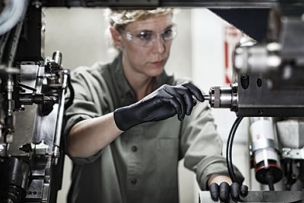MCR Safety has over forty years of experience as a leader in the field of personal protective equipment (PPE). Our assortment of offerings includes gloves, glasses, and garments which are made from the highest quality materials available to ensure maximum safety, comfort, and style.
Welcome, Machinists. You are the backbone of the industries that keep the world moving. Machinists are entrusted with the intricate task of crafting precision components and parts, ensuring the very essence of innovation and progress. Without machinists, the manufacturing process would halt, leading to a shortage of critical products and technologies, ultimately disrupting the supply chain.
As crucial as this profession is, it comes with a several perils, as machinists work in environments fraught with potential hazards, from the risk of injury from heavy machinery to sharp objects and puncture hazards. Those who work the lathe know that a small metal fragment, propelled by the rapid rotation of the workpiece, can dislodge and fly toward the operator's face. Without the protection of safety glasses or goggles, the metal fragment can strike the operator's eye, causing severe injuries such as corneal abrasions, eye infections, or even permanent vision impairment. These risks underscore the critical need for comprehensive safety measures and the proper use of personal protective equipment (PPE) to ensure the well-being of these skilled workers while they keep industries running smoothly.
In this comprehensive article, MCR Safety will delve deep into the world of machinists, understanding what they do, the industries they serve, and, most importantly, how to keep them safe. MCR Safety is here to provide essential protective gear like work gloves and safety glasses to safeguard these crucial workers. Let's embark on this journey together, exploring the life of a machinist and the vital role PPE plays in their safety.
What is a Machinist?
Machinists are skilled artisans with the expertise to precisely shape, modify, and fabricate metal and other materials. They operate various machines, including lathes, milling machines, and grinders, to create intricate parts and components essential to various industries. These highly trained professionals are like the magicians of the manufacturing world, turning raw materials into functional parts that power our everyday lives.
What does a machinist do?

Machinists engage in many day-to-day activities, each contributing to the seamless functioning of machines and industries. From setting up and preparing machines to welding, grinding, and performing maintenance, their tasks are as diverse as the products they create. They work with metals, plastics, and other materials, ensuring everything is precise and meets industry standards.
Industries
Machinists are the backbone of several industries, ensuring that machines run smoothly and efficiently. From crafting parts for vehicles to drilling pieces for medical equipment, the precision and accuracy of their work directly impacts the reliability and safety of these products. They play a crucial role in the following sectors:
- Fabricated Metal Product Manufacturing: Responsible for crafting metal parts and components used in various applications.
- Machinery Manufacturing: Involved in producing machinery used across different industries.
- Transportation Equipment Manufacturing: Contribute to creating vehicles, from automobiles to airplanes.
Work Activities
In the dynamic and demanding world of machining, machinists engage in various intricate and technical work activities, each demanding high skill and precision. This work is not just about operating machinery; it's about shaping the future one component at a time. The tasks range from the meticulous programming of CNC machines for precision part production to manual machining, where every turn of the handwheel matters. Machinists also engage in detailed assembly and finishing work, ensuring each part meets the exact specifications. Regular maintenance and inspection are equally crucial, as they guarantee the ongoing accuracy and functionality of the machinery.
Here are some of the top machinist activities that require personal protective equipment (PPE):
- Cutting and shaping metal: Precision cutting and shaping metals using machinery.
- Welding and grinding: Joining metal parts through welding and finishing them with grinding.
- Handling hot metals: Dealing with high temperature metals during the manufacturing process.
- Operating machinery: Running machines with rotating parts and mechanisms.
- Cleaning and maintenance: Regularly cleaning and maintaining machines and work areas.
Machinists must employ robust protective measures to safeguard against these eye hazards. Each task, whether cutting and shaping metal, welding, grinding, or handling hot metals, calls for specific types of PPE to protect these skilled professionals. Through this combination of expert craftsmanship and rigorous safety practices, machinists continue to shape our world with precision and care, maintaining the high standards and reliability expected in modern manufacturing.
Continue reading this blog in its entirety to learn about common safety hazards that machinists face and the PPE that MCR Safety offers to mitigate potential injuries and lost productivity.
Previously Featured on MCR Safety's blog.
Browse PPE from MCR on MSCDirect.com.









Talk to Us!
Leave a reply
Your email address will not be published. Required fields are marked *